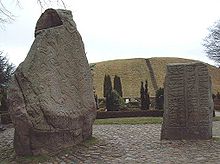Etymology of Denmark
The etymology of the name Denmark (
]According to medieval legend, the name Denmark refers to the mythological King Dan. There are also a number of references to various Dani people in Scandinavia or other places in Europe in Greek and Roman accounts (like Ptolemy, Jordanes, and Gregory of Tours), as well as some medieval literature (like Adam of Bremen, Beowulf, Widsith and Poetic Edda).
Most handbooks derive[3] the first part of the word, and the name of the people, from a word meaning "flat land", related to German Tenne "threshing floor", English den "low ground", Sanskrit dhánus- (धनुस् "desert") [Sanskrit dhánus means 'bow', survived by its modern usage in Hindi]. The -mark means woodland or borderland (see marches), with probable references to the border forests in south Schleswig,[4] comparable to Finnmark, Telemark, or Dithmarschen.[5]
Mythological explanations
Some of the earliest descriptions of the origin of the word 'Denmark', describing a territory, are found in the Chronicon Lethrense (12th century), Svend Aagesen (late 12th century), Saxo Grammaticus (early 13th century) and the Ballad of Eric (mid 15th century). There are, however, many more Danish annuals and yearbooks containing various other details, similar tales in other variations, other names or spelling variations.
The Chronicon Lethrense explains how the
Earliest occurrences

The earliest mention of a territory called "Denmark" is found in King
In the
The first recorded use of the word "Denmark" within Denmark itself is found on the two Jelling stones, which are rune stones believed to have been erected by Gorm the Old (c. 955) and Harald Bluetooth (c. 965). The larger stone of the two is popularly cited as Denmark's baptismal certificate (dåbsattest),[9] though both use the word "Denmark", in the form of accusative ᛏᛅᚾᛘᛅᚢᚱᚴ "tanmaurk" ([danmɒrk]) on the large stone, and genitive "tanmarkaR" (pronounced [danmarkaɽ]) on the small stone.[10] The inhabitants of Denmark are there called "tani" ([danɪ]), or "Danes", in the accusative.
In
References
- ^ Kristian Andersen Nyrup, Middelalderstudier Bog IX. Kong Gorms Saga Archived 2010-01-09 at the Wayback Machine
- ISBN 978-87-7674-204-1, pp. 19–24
- J. de Vries, Altnordisches etymologisches Wörterbuch, 1962, 73; N. Å. Nielsen, Dansk etymologisk ordbog, 1989, 85–96.
- ^ Navneforskning, Københavns Universitet Udvalgte stednavnes betydning Archived February 16, 2008, at the Wayback Machine.
- ^ Asernes æt Daner, Danir, Vandfolket
- ^ The 'David' referred to here appears to be David, the ancient king of the Israelites: of course this is wildly anachronistic, but it is fairly typical of such sources, which commonly sought to push national or dynastic origins as far back as possible.
- ^ Thorpe, B., The Life of Alfred The Great Translated From The German of Dr. R. Pauli To Which Is Appended Alfred's Anglo-Saxon Version of Orosius, Bell, 1900, p. 253.
- ^ Thursten, p. 67.
- ISBN 9780470776834. Retrieved 2014-02-27.
- ^ The dative form tąnmarku (pronounced [danmarkʊ]) is found on the contemporaneous Skivum stone.
